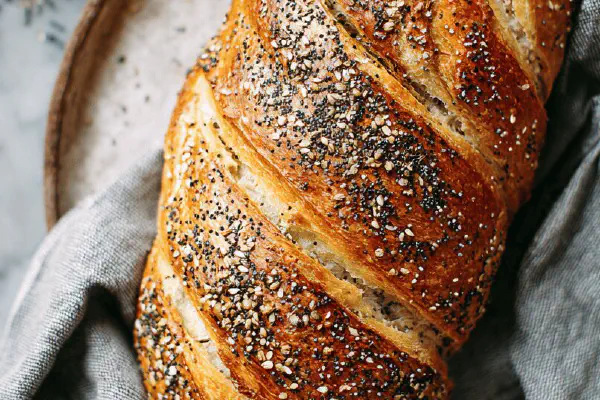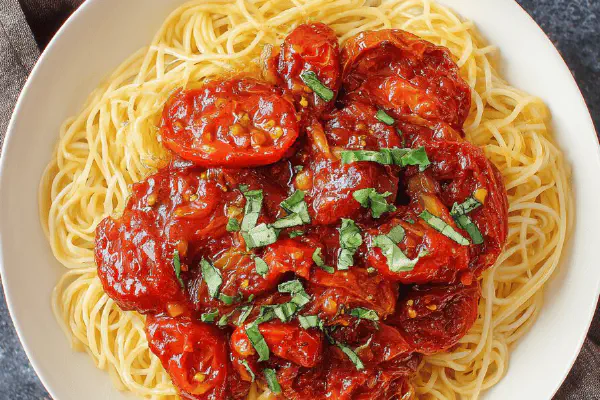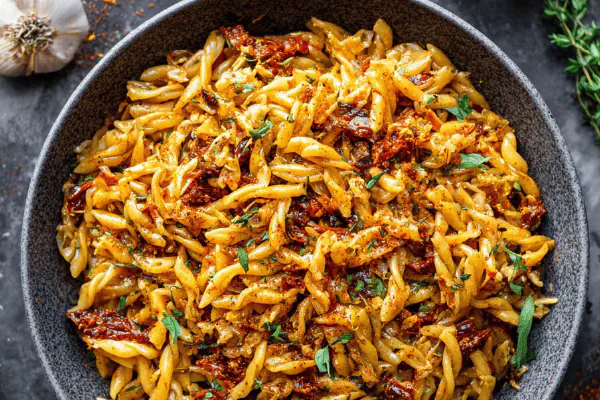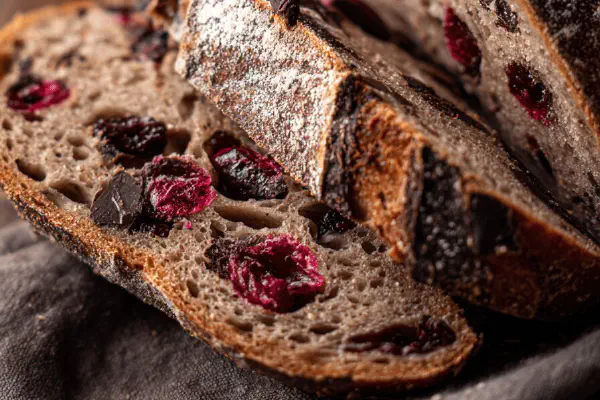Seeded Ciabatta Twist

By Emma
Certified Culinary Professional
Ingredients
Quick Levain
- 105 g (3/4 cup) unbleached all-purpose flour
- 110 ml (1/2 cup) room temperature water
- 2 ml (1/3 tsp) instant yeast
Dough
- 12 ml (2 1/2 tsp) toasted sesame seeds
- 12 ml (2 1/2 tsp) chia seeds
- 12 ml (2 1/2 tsp) fennel seeds
- 320 ml (1 1/3 cup) room temperature water
- 420 g (2 3/4 cups) unbleached all-purpose flour
- 50 ml (3 1/2 tbsp) olive oil
- 6 ml (1 1/4 tsp) salt
- 12 ml (2 1/2 tsp) fine semolina or cornmeal
About the ingredients
Method
Quick Levain
- Mix flour, water, yeast vigorously in large bowl till uniform. Cover with cloth, rest at room temp about 1h40m till volume doubles and surface bubbly, bubbly = good, if not wait 10-15m more.
Seed Mixture
- Combine sesame, chia, fennel seeds in small bowl. Toast lightly if not toasted already for punchy aroma, but if seeds fresh, raw okay.
Dough Assembly
- Pour water into levain. Whisk briefly to break lumps but some lumps okay. Add flour, olive oil, and salt. Stir with spatula or wooden spoon about 3 minutes till dough absorbs flour and shiny. Throw in seed mix, incorporate well. Cover. Rest 25 minutes to hydrate.
Stretch and Fold
- Wet hand, reach in bowl, grab dough edge stretch away, fold back over dough pile. Rotate bowl quarter turn. Repeat this fold-thrust-four times. Dough feels stronger, smoother now. Cover. Rest 1h50m or refrigerate overnight if planning ahead. Look for dough puffiness not bounce back too quick.
Prep for Baking
- Line 33x46 cm baking tray upside down with parchment. Spread semolina or cornmeal evenly on paper. It forms gritty crust layer below loaves.
Shaping
- Flour workspace generously. Turn dough out carefully, no squashing. Dust dough top with flour. Pick up dough at sides, stretch gently, flatten to rough 45x28 cm rectangle. Don’t press flat, retain bubbles. Fold long edges inward to form long log shape, like baguette but shorter. Use bench scraper or knife. Cut evenly into 8 portions.
- Place them spaced apart on semolina sheet. Dust tops lightly. Cover loosely with kitchen towel. Let rest 40-50 minutes. Dough should inflate slightly, light to touch, slight spring back.
Oven Prep
- Middle rack is better than center for even heat, place an inverted sheet tray on rack below to create hot surface. Preheat oven to 245 °C (475 °F).
Baking
- Slide tray with parchment and loaves onto hot inverted tray. Close door fast. Drop oven temp to 220 °C (430 °F). Listen for oven spring – audible crackling first 5 minutes. Bake 20-23 minutes till loaves golden brown, crust crisp, tap bottom and hear hollow sound.
- Cool fully on wire rack. Crust should feel firm, crumb open with irregular holes, seeds toasty in each bite.
Cooking tips
Chef's notes
- 💡 Levain starter needs vigorous stirring; air means yeast alive. Wait for bubbled top, if not, extend timing but check water temp and yeast freshness. Too cold water slows things; too hot kills yeast. Use room temp water steady–steady activity, avoid sudden temp jumps.
- 💡 Stretch and fold technique beat slap-and-fold here. Wet your hand enough to keep dough from sticking but not dripping. Stretch edges gently, fold back–repeat quarter turns. Builds gluten gently, texture tightens slowly. Folds faster means less stick on fingers but watch dough feel.
- 💡 Seed mix toasted lightly unlock oils, aroma pops—too raw brings slight bitterness. Toast quickly on dry pan; don’t burn. Incorporate seeds post dough mixing to prevent crushing seeds under heavy knead. Seeds swell slight during proof but keep shape.
- 💡 Oven heat needs balance. Preheat oven hot, tray underneath flipped for direct heat to bottom crust. Slide parchment with dough quickly to avoid temp dips. Original 245 dropping to 220 sets crust sharp, crust crackle audible first 5 minutes. Avoid oven door open under first 10 minutes.
- 💡 Shaping crucial; avoid squashing air bubbles. Dough stretched to specific rectangle, fold edges inward rather than pressing flat. Cuts into loaves maintain air pockets. Resting after shaping lets dough inflate slightly. Use surface semolina dust for rustic bottom texture, grains act like sandpaper under loaf.
Common questions
Why does levain not bubble after 2 hours?
Yeast inactive or water too cold. Check yeast freshness. Extend wait but bubbles crucial–no bubbles, no rise downstream. Stirring introduces air–skip that, yeast lazy. Room temp varies; too hot kills, too cold slows.
Can whole wheat flour substitute here?
Yes, but add extra water 10-20 ml. Denser dough expected. Alters gluten network; crumb tighter, less open. Seed balance ok same. Longer proof recommended. For spelt, similar adjust water. Gluten strength differs.
How to avoid gummy crumb?
Cool fully on wire rack. Cutting early traps steam in crumb, makes sticky texture. Resting helps gel crumb structure firm up. Also, don’t overwater dough; hydration tweaking changed here helps dryness. Also avoid heavy pressing after proof.
Best storage for leftover ciabatta?
Multiple options. Room temp in paper bag keeps crust crisp but short term. For longer, freeze whole or sliced; defrost at room temp. Avoid plastic bags long-term or crust softens. Toast reheats crust surface crisp better than microwave. Moisture balance key.



